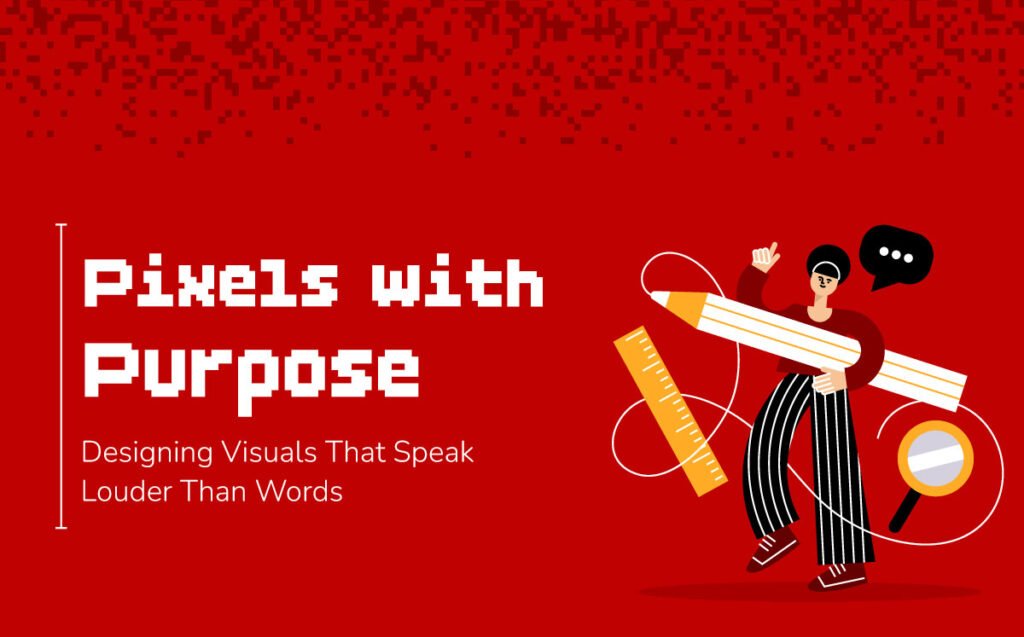A design without purpose is just decoration.
In today’s attention-hungry digital world, visuals communicate much better and are not just about looking good. You shape perceptions when you are a designer not sketching pixels on a blank canvas. You narrate tales, and you form bonds.
Welcome to the art (and challenge) of purpose-driven design.
Why Pixels Need Purpose
Let’s face it—people scroll fast. Your audience gives you 3–5 seconds before deciding whether to stay or swipe away. Words take time, but visuals hit instantly. That’s why a purposeful design can do what paragraphs often can’t—deliver a message straight to the heart.
Fact check: Studies say the brain handles 90% of facts by sight, and images stay in memory 65% more than text.
Visuals speaking much louder than just words have all of that power.
The Hook: Design Is Not Just Art—It’s Strategy
Design isn’t about “making things pretty.” It’s about solving problems. A pixel-perfect design must balance creativity with strategy:
-
Branding that breathes personality – From logos to social posts, visuals should echo the brand’s voice.
-
User experience that feels invisible – Great design guides users without them even realizing it.
-
Emotion that builds connection – Every color, font, and layout choice affects how someone feels.
Designers aren’t just artists. We are translators of emotions, values, and visions through the use of pixels.
The Designer’s Dilemma: The Struggles No One Talks About
Behind every stunning graphic is a designer wrestling with realities:
-
Clients who say “make it pop” without context. (Translation: You’re on your own to decode that mystery brief.)
-
Endless revisions. That “one last change” rarely means one last change.
-
Balancing trends with timelessness. Should you follow the hot gradient trend or design something that lasts five years?
-
Time vs. creativity. Deadlines are tight, inspiration is not always on-demand.
-
The battle of pixels vs. words. Sometimes, copy doesn’t align with visuals—and you’re expected to fix both.
Designing visuals includes research, psychology, storytelling, with empathy stitched inside a single frame. It is more than simply clicking in Figma or Photoshop.
The Science Behind Purposeful Pixels
A purposeful design isn’t born by accident—it’s built on psychology and human behavior:
-
Color psychology: Red provides excitement, blue provides calmness, green provides reassurance. Color sets the tone before words, so choose wisely.
-
Typography impact: Fonts whisper or scream. Serif = trust & tradition. Sans serif = modern & clean.
-
Visual hierarchy: The human eye follows patterns. A good design directs attention exactly where it should.
-
Minimalism vs. overload: Empty space isn’t empty—it’s breathing room. Clutter kills clarity.
Every pixel carries weight. Misplace one, and you change the entire conversation.
From Idea to Impact – The Designer’s Checklist
If you want your visuals to speak louder than words, here’s a checklist to guide your design journey:
-
Ask “Why?” before “How?” – What’s the purpose? Awareness, sales, engagement, emotion? The “why” defines the design.
-
Know your audience. Designing for Gen Z is not the same as for corporate professionals. Context changes everything.
-
Keep it simple, but significant. Don’t over-design. A single bold element is more memorable than ten scattered ones.
-
Consistency is silent power. Align colors, fonts, tone across platforms—branding becomes effortless recognition.
-
Design with adaptability. What looks good on Instagram should also work on a billboard.
Pixels That Changed the World (Quick Examples)
-
Nike’s swoosh: A single curve that screams motion.
-
Apple’s minimal ads: Clean space, strong product focus, emotional pull.
-
UNICEF campaigns: Stark imagery that moves people to act faster than words.
These designs didn’t just exist. They persuaded, provoked, and performed.
The Hard Truth: Design Is Invisible When Done Right
Good design doesn’t scream, “Look at me!” It whispers, “You understand this effortlessly.”
The audience rarely notices great design—they only notice when it’s missing or poorly done.
Design is the silent ambassador of every brand.
SEO Insights for Designers (Yes, You Need Them!)
Designers often shy away from SEO, but here’s the truth: visuals need visibility. To ensure your designs don’t just exist but also reach the right audience:
-
Use alt-text on images – It boosts search visibility and accessibility.
-
Incorporate keywords naturally in design blogs and case studies. Example: graphic design trends, purpose-driven design, visual storytelling, branding design, creative strategy, user experience design.
-
Optimize image size – A slow site kills engagement.
Pro tip: A brilliant design unseen is just a file on your desktop. Visibility makes it valuable.
Closing Note – Designing for Impact, Not Just Aesthetics
At the end of the day, your role as a designer isn’t just to create something “beautiful.” It’s to create something meaningful. Pixels with purpose have the power to shape opinions, influence decisions, and spark movements.
Remember: Anyone can design visuals, but not everyone can design impact.
So next time you open that Figma file or Illustrator board, ask yourself:
“Am I decorating, or am I communicating?”
Because the world doesn’t need more pretty pictures—it needs visuals that speak louder than words.

